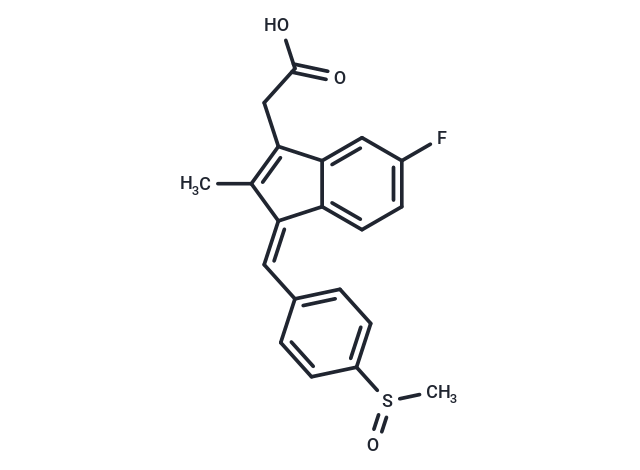Shopping Cart
- Remove All

Your shopping cart is currently empty


| Pack Size | Price | Availability | Quantity |
|---|---|---|---|
| 50 mg | $40 | In Stock | |
| 100 mg | $47 | In Stock | |
| 200 mg | $66 | In Stock | |
| 500 mg | $97 | In Stock | |
| 1 mL x 10 mM (in DMSO) | $50 | In Stock |
| Description | Sulindac (Sulindac sulfoxide) is a sulfinylindene derivative prodrug with potential antineoplastic activity. Converted in vivo to an active metabolite, sulindac, a nonsteroidal anti-inflammatory drug (NSAID), blocks cyclic guanosine monophosphate-phosphodiesterase (cGMP-PDE), an enzyme that inhibits the normal apoptosis signal pathway; this inhibition permits the apoptotic signal pathway to proceed unopposed, resulting in apoptotic cell death. |
| In vitro | In intestinal tissues of Min/+ mice, Sulindac does not alter the levels of PGE2 and LTB4 but reduces the number of tumors. Within a mouse model of familial adenomatous polyposis, Sulindac decreases small intestine COX-2 and prostaglandin E (2), thereby inhibiting tumor formation. |
| In vivo | In colorectal cancer (CRC) cell lines, Sulindac and its metabolites sulindac sulfide and sulindac sulfone inhibit the NF-κB pathway, reducing IKKbeta kinase activity mediated by Sulindac. In HT-29 cells, Sulindac significantly reduces cell growth. Sulindac inhibits cell proliferation across various epithelial and fibroblast tumor cell lines. In CRC cell lines DLD1 and SW480, Sulindac suppresses beta-catenin/TCF-mediated gene transcription and decreases levels of non-phosphorylated beta-catenin. |
| Alias | Arthrocine, MK-231, Clinoril, Sulindac sulfoxide |
| Molecular Weight | 356.41 |
| Formula | C20H17FO3S |
| Cas No. | 38194-50-2 |
| Storage | Powder: -20°C for 3 years | In solvent: -80°C for 1 year | ||||||||||||||||||||||||||||||||||||||||
| Solubility Information | Ethanol: 9 mg/mL (25.25 mM) DMSO: 50 mg/mL (140.29 mM) | ||||||||||||||||||||||||||||||||||||||||
Solution Preparation Table | |||||||||||||||||||||||||||||||||||||||||
DMSO/Ethanol
DMSO
| |||||||||||||||||||||||||||||||||||||||||

Copyright © 2015-2024 TargetMol Chemicals Inc. All Rights Reserved.